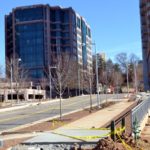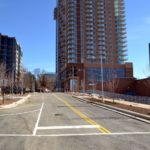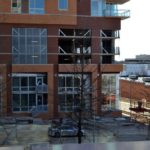 It may come as a surprise to many, but part of the Board of Supervisor’s plans to create a more urban transportation network for Tysons reached a first, but significant, milestone recently.
It may come as a surprise to many, but part of the Board of Supervisor’s plans to create a more urban transportation network for Tysons reached a first, but significant, milestone recently.
For those who didn’t follow the process of the Comprehensive Plan for Tysons, as shocking as that might sound to me, a significant component of the plan was the establishment of a street grid for the growing region. The current road network is more akin to suburban office parks, where individual developments do not necessarily communicate with their neighbors in terms of public road access, creating what many call “mega-blocks”.
This arrangement has increasingly become detrimental to both pedestrian and vehicular access to the commercial downtown, forcing all onto congested arterial corridors like Route 7 and Route 123, where other cities have multiple parallel roads that can help siphon off that funneling effect. The added benefit to a street grid is a more human scale, traversable to pedestrians and cyclists, blocking pattern.
We are now able to say that the first in a long line of developer funded street grid links is now in place, and ready to be connected to future projects. It exists on the north side of Georgelas’ Ascent property at Spring Hill Station.
While it may not look like much, it is a precedent signifying the feasibility of the concept as a whole; with proper planning, infrastructure can be incorporated without any additional costs to either the developers or the public, like measuring twice and cutting once.
The Ascent property, managed by Greystar, has completed construction of the building and is moving forward with leasing, but the final touches to the road have been pending improved weather conditions. The good news is the costly elements like the underlying structural aggregate, pavement, and much of the sidewalk network are all in place, and the remaining components are all marketable improvements to the property which touts urban access to transit.
The very minor, in the grand scheme of planned changes, improvement isn’t much to cheer about by itself, but it is essential to the new era in Tysons, showing that with proper foresight and communication between public and private interests, a new culture of multi-modal access can be implemented without headaches.






